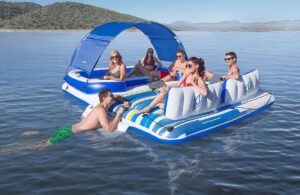DOES A DOCTOR’S prescription to go boating sound too good to be true? Maybe not. A walk on the beach, paddle on the bay or day out on a boat is the perfect way to produce a healthful state of “Blue Mind.”
Blue Mind is a term coined by marine biologist Dr. Wallace J. Nichols, author of the New York Times best-selling book of the same name. In the book, he describes the ages-old bond and calming effects of spending time in, on or gazing out at the water’s blue. It’s a concept Nichols put a name to in 2014, and it’s even more important in today’s stressful climate to spend time in a blue state of mind.

“The opposite of Blue Mind is Red Mind, or when we feel anxious and uncertain. There’s a lot of Red Mind, because modern technology keeps us hyper-connected. Now, add the pandemic. The incidence of Red Mind increased 10 times. Red Mind evokes our sense of fight or flight, and stress hormones kick in. Over 60% of disease today is caused or worsened by stress.
“Blue Mind melts stress. Engaging with water — whether in a bathtub, pool or the ocean — keeps Red Mind from overwhelming us and progressing to Gray Mind or sickness and burnout,” explains Nichols, who founded the Live Blue Foundation and today is a senior fellow at the Center for the Blue Economy at the Middlebury Institute of International Studies, in Monterey, CA.
Passing the Test of Time
Mankind’s connection between water and well-being go way back in time. Ancient Greek physician Hippocrates wrote several treatises with comments about the impact of water on people’s health. Romans built baths on the hot springs in Bath, England, and “taking the waters” here was thought to cure a variety of ills. In the 18th century, British physicians often prescribed a swim, dunking in a cold ocean, as a seaside cure for everything from depression to digestive upsets.
More recently, when president and avid sailor John F. Kennedy gave a speech in 1962 at the America’s Cup dinner in Newport, RI, he perfectly nailed the basic bond between man and the sea: “All of us have in our veins the exact same percentage of salt in our blood that exists in the ocean, and therefore, we have salt in our blood, in our sweat, in our tears. We are tied to the ocean. And when we go back to the sea — whether it is to sail or to watch it — we are going back from whence we came.”
The sea works its soothing effects through our senses, according to Nichols. Visually, you turn away from the chaotic scene of everyday life and look toward the mesmerizing sight of the sea. Auditory, you escape honking horns, maddening music and a cacophony of conversations to hear the white noise of the rhythmic whoosh of the waves. Finally, you feel cocooned in a safe place by the sense of touch while floating in the water. These are all ways, says Nichols, that Blue Mind helps you relax, clear away the Red Mind and get more bandwidth back in your brain.

Blue Mind, far from an abstract concept, is backed by science. For example, in 2012 Dr. Benedict Wheeler and his colleagues at the University of Exeter Medical School in the United Kingdom tested the idea that living by the coast improves health and well being. They analyzed census data to do this and found the premise true, due to the stress reduction and physical activities the ocean and beachside present.
Four years later, Japanese researchers, using questionnaire research on more than 500 residents, found those who lived near the sea showed greater positive emotions such as peace and calm, compared to those living inland. In 2017, Spanish researchers reviewed 35 studies on this topic. Results revealed an overall positive association between greater exposure to outdoor blue spaces and mental health, especially in terms of stress reduction and a sense of well-being.
How can you make Blue Mind work for you?






